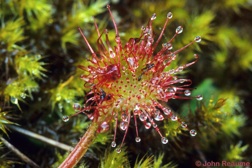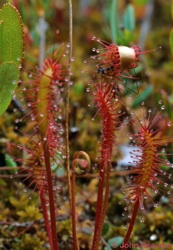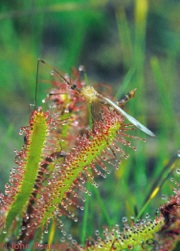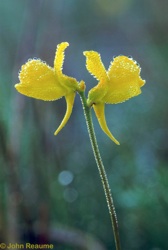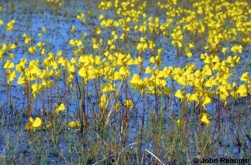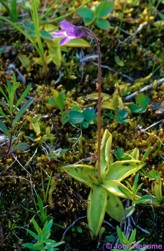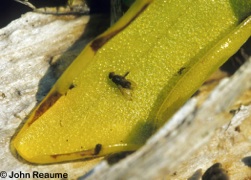Pitcher Plant (Sarracenia purpurea)
The
Pitcher Plant is the floral emblem of Newfoundland and Labrador. It is known by many other common names such as the Common Pitcher Plant, Purple Pitcher Plant, Flytrap, Side-saddle Plant, Huntsman’s Cup and Frog’s Britches. This perennial plant has upright tubular leaves that form a rosette. The tubes are wider at the mouth and have a vertical hood on one side. The colour varies from yellow-green to purple (the Latin name
purpurea = purple) or somewhere in between. There is a strong red venation pattern on the leaves as well that probably help to attract insects. The leaves have a keel on one side to maintain its vertical strength and help it to hold water. These carnivorous plants are generally found in poor soil conditions such as acidic bogs and rely on their ability to capture insects as a source of phosphorus, nitrogen as well as vitamins and trace minerals that are not available in the soil. The roots are poorly
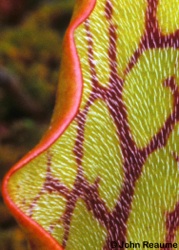
developed and mainly used to anchor the plant as there is little to absorb from the soil as noted above. Insects are attracted to the red lip and follow the red veins (baited with nectar) downwards into the plant. The curve of the tube is lined with downward pointing fine hairs (note photo at right) that prevent the prey item from climbing back out of the tube. Eventually the prey falls into the water that is filled with digestive enzymes from the plant that gradually dissolves the victim and extracts the critical nutrients. These plants are truly carnivorous (not just insectivorous) consuming not only insects but mites, spiders and even small frogs. Interestingly there are some insects that benefit from the Pitcher Plant. Bees are attracted to the nectar of the flower (a single purplish-red to maroon flower on a leafless stem) and there is even a mosquito (non-biting) called
Wyeomyia smithii that has its larval stage in the fluid of the plant and is unharmed by the digestive enzymes! The genus name
Sarracenia is from Michel Sarrazin (1659-1734) who was a French physician and botanist.
Sundews
Round-leaved Sundew (Drosera rotundifolia), Spatulate-leaved Sundew (D. intermedia) and Linear-leaved Sundew (D. linearis)
The genus name
Drosera comes from the Greek “droseros” meaning dewy or watery. This is an excellent descriptor as the plants always have a sticky secretion on the tips of the hairs that line their leaves and are used to help trap insects. These plants are also found in poor soil conditions where competition with other plants is limited allowing more exposure to the sun - the secretions are greatest when the sun is at its height thus resulting in the common name of “sundew” for this group of plants. The
Round-leaved Sundew (pictured above) is also known as the Common Sundew, Dew Plant, Red Rot and Youthwort. Its leaves are splayed out in a basal rosette with the glandular tipped hairs appearing on the upper surface of the leaves. Once insects are trapped by the sticky secretions the leave edges fold in around the prey (as noted in the photo at the right of a Spatulate-leaved Sundew) and then secrete enzymes that digest and absorb the nutrients that are not available from the poor soils where this short-lived herb is found. Interestingly the plant seems to be able to tell the difference between organic and inorganic material as it will
not secrete its enzymes when inorganic material is trapped in the leaf ! Some insects even benefit from the Sundews as one researcher noted that up to 2/3 of the trapped insects were scavenged by ants in the study area. The
Spatulate-leaved Sundew (right photo) is also known as the Oblong-leaved Sundew or the Spoonleaf Sundew. Its blades are about 2 - 3 times long as they are wide. The
Linear-leaved Sundew (pictured on the left) is also known as the Slenderleaf Sundew or the Slender-leaved Sundew. Its leaves are much longer - averaging 2 - 5 cm long but only 1-2 mm wide. These plants have had medicinal uses over the years - the leaves have the ability to curdle milk and have been used in Sweden in the making of cheese. The secretions have been used in the treatment of warts and because of the “dews” ability to thrive in the hot sun it was felt that the plant possessed the property to endow longevity if drank (hence one of the common names of “Youthwort”)
Horned Bladderwort (Utricularia cornuta)
The genus name
Utricularia is from the Latin “utricularius” meaning “the master of a raft that is floated on bladders” where the species name
cornuta comes from the Latin “cornutus” meaning “horned”. The
Horned Bladderwort (left photo) is also known as the Leafless Bladderwort. The downward pointing spur on the yellow flower is quite distinctive. The plant does actually have leaves but these are threadlike and found underground where it grows in wet places such as near acid lakes, sandy or muddy shores or in peat bogs. The leaves and the roots of this plant have tiny, carnivorous bladders which can trap and digest small invertebrates. The bladders are essentially small deflated sacks that open abruptly when
sensitive trigger hairs are disturbed. This creates a vacuum which then sucks in water and the prey item that set off the trap. Digestive enzymes are then secreted into the bladder and along with bacteria that live in the bladder the prey item is digested and its nutrients extracted into the plant by specialized cells. As the fluid is absorbed the vacuum is recreated thus resetting the trap. Other species of Bladderwort found in Ontario (not pictured here) include: Inverted Bladderwort
(U. resupinata), Common Bladderwort
(U. vulgaris), Intermediate Bladderwort
(U. intermedia) and Purple Bladderwort
(U. purpurea).
Common Butterwort (Pinguicula vulgaris)
The genus name
Pinguicula is from the Latin “pinguis” meaning fat which is in reference to the leaves which appear to be soft and fleshy with a greasy texture. The
Common Butterwort is found in calcium rich sites such as along sandy or rocky shorelines. It is a carnivorous, perennial plant with a solitary purple flower that has a white throat. It has 3 - 6 basal leaves that form a rosette. They are yellow-green in colour and have a sticky upper surface with in-rolled margins. The leaves act essentially like fly-paper. The insect prey get stuck on the sticky secretions - the leaf gradually curls inwards enveloping the insect and then secretes the digestive enzymes that breakdown the victim such that the leaf can absorb the necessary nutrients. Later the leaf uncurls releasing the indigestible parts of the insect.
Images can be supplied in a variety of formats. In some cases original slides or high resolution scans could be sent. Otherwise images can be sent in Raw format, tiff or jpeg format at varying resolutions as required for use. Images will not have the copyright information on them unless specially requested. Please identify the image by its unique name/number combination when making any inquires (see information under Contact menu).
Note: All images used on this site are exclusively the property of and copyrighted under John Reaume. Copying, downloading, saving, displaying, distributing, reproducing in any format without the expressed permission of John Reaume is strictly forbidden. All photos are subject to licensing fees that vary depending on intended use. For further information please contact John Reaume as shown under the Contact section. Site design and maintenance by John Reaume.




